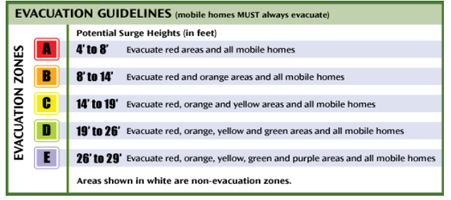Hurricane and Natural Disater Preparedness
Hurricane Season begins June 1st and ends November 30th. Don't wait till store shelves are empty, prepare now. Create a disasterplan before a hurricane is announced, complete home improvements during the cooler days of the year, and organize important papers so you can grab them quickly
Hurricane Preparedness Guide
2025-Hurricane-Guide_English.pdfKnowledge is Power –
From panic to peace of mind
Getting prepared for any type of disaster is a simple matter and it starts with knowing what you will need to do. It’s the first step to keeping yourself and your family safe.
Here in Pinellas County, there is the potential for hazards as a result of severe weather or man-made disasters. One of the greatest hazards that we face is hurricanes, with the Atlantic Hurricane Season running June 1 to Nov. 30. Basic steps should be taken year-round to keep yourself, your family, and your property safe.
This guide offers useful information to help everyone make a plan, whether you are a homeowner or renter, have a special need or know someone who does, and whether you have children, pets, or a business. Tailor your plan to your life.
After you use this guide, put it in a safe place with your other important papers, and rest assured that you have planned to replace panic with peace of mind. Check out the Hurricane Preparedness Guide by visiting: www.pinellascounty.org/emergency/allhazardguide.htm
Prepare an Emergency Survival Kit
Following an emergency or disaster, you may lose access to basic services, such as power and water, and be subject to limited or no access to essentials like food and water. With that in mind, stock up on essentials now and build a disaster supply kit to last you and your family for a minimum of 7 days.
- Stay kit: one-week supply of food that requires no cooking, drinking fluids, non-electric can opener, one gallon of water per person per day, cups, plates and plastic utensils, cooler and ice, pet food.
- First Aid Supplies: bandages, gauze pads and tape, soap and anti-bacterial gel, scissors and tweezers, sunscreen, pain reliever and anti-itch cream
- Tools and Emergency Supplies: flashlights, battery-operated radio, extra batteries, matches or lighter in water proof container, maps with shelter locations, shut-off wrench and other tools, paper and pencil and plastic sheeting and tarps
- Sanitation: Portable toilet (5 gallon bucket, heavy trash bags, chlorine bleach) toilet paper and moist tissues, feminine supplies and personal hygiene items
- Clothing and bedding: One complete change of clothing and shoes per person, sturdy shoes or boots, rain gear, blankets and sleeping bags, sunglasses
- Kids and entertainment: Favorite nonperishable snack, powdered milk, favorite toy/stuffed animal, diapers and wipes, blanket and pacifier, board games, coloring books and colors, playing cards, etc.
Know your evacuation zone

- Check out the following website: http://egis.pinellascounty.org/apps/knowyourzone/
- Call Pinellas County Interactive Hurricane Evacuation Inquiry Line at 727-453-3150 and key in your home phone number without the area code to hear your home's evacuation zone
- Check your county utility bills and the Truth in Millage (TRIM) sent by property appraiser, they will contain your evacuation zone.
Hurricane Preparedness Tips for Parents

